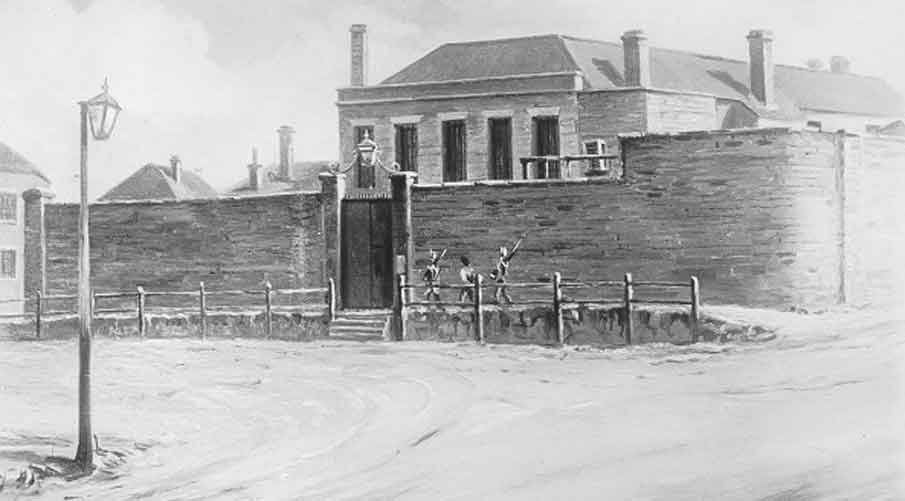
Mathew Brady
1799 – 1826
Our namesake was a hit with the ladies, just like our ciders.
The gentleman bushranger
Mathew Brady (a.k.a. Matthew Bready) was one of 160 convicts transported to Van Diemen’s Land (now known as Tasmania) on the Juliana on 3rd September 1820.
Born of Irish parents at Manchester, he had been quite well educated and wrote a good hand. Employed as a groom in a gentleman’s establishment, he was renowned for his horse-riding abilities.
Mathew Brady was one of Tasmania’s first and most infamous bushrangers. (Image: Wikipedia)
Known to have a keen sense of humour, it appears as though Brady was treated like a family member of his employer. That is, until he became involved in a theft whereby he stole a basket, a firkin of butter, a twelve-pound flitch of bacon, thirty pounds of sugar and two pounds of rice. The total value of the goods was five shillings, and the intended recipients were two young, unmarried maidens from his hometown. For the theft, he was sentenced to seven years transportation to Australia. First sent to New South Wales, it wasn’t long before he was transported across to Van Diemen’s Land.
During his four years as a convict - first in New South Wales then in Tasmania - Brady received 350 lashings for various escape attempts and misdemeanours. (Image: Wikipedia Commons)
Despite being consigned to a family who treated him well upon his arrival, Brady ran away and hid on a ship that was bound for England. Discovered before the ship sailed from port, he was taken ashore in irons and sent straight to jail. Assigned a harder master by way of punishment, it wasn’t long before Brady managed to stow away for a second time. Discovered again and deemed a flight risk, Brady was sent to Macquarie Harbour, where it was said from which there was no escape. There, he served on Sarah Island for over two years before managing to escape by boat.
Attracting a band of like-minded followers, Brady was on the run with his gang from 1824. Together, they committed many audacious crimes, including the capture of the Sorell goal. Making his way across the state, he eventually found himself wandering the lands of the Tamar Valley.
Unsatisfied with life in the Colony, the gang began to contemplate their means of escape from Van Diemen’s Land. Venturing up a hill (now known as Brady’s Lookout) to view the position of the Glory - another potential ship to stow away on – Brady could not see the future that was about to befall him.
After 21 months of being blissfully free to roam Van Diemen’s Land, he was betrayed by an ex-convict who was seeking a pardon for his own crimes. Escaping the ensuing gun battle with serious injuries, Brady was soon captured by the bounty hunter, John Batman.
Bounty Hunter John Batman, also known as the founder of Melbourne.
(Image: Wikipedia)
Despite his brash crimes, Brady was known as The Gentleman Bushranger due to his gentle and respectful treatment of women. At his trial, the court was crowded with sympathising ladies, who wept at the recital of his sufferings and the enormity of his crimes. Brady’s chivalrous behaviour towards females had won their esteem, and the brilliant feats of this career had excited many imaginations.
Petition after petition was received by the Governor to seek a reprieve from hanging. His cell was besieged with visitors, and his table with flowers. However, a reprieve was not to be and he was hanged in 1826.
The Old Hobart Goal, where Brady was held prior to his hanging in 1826.
(Image: The Archives Office of Tasmania no. AB713-1-5808)
-
-
The Bushrangers; illustrating the early days of Van Diemen's Land. A facsimile of the original edition published in 1856, Fullers Bookshop, Hobart.
-
Brady: Van Diemen’s Land 1824-1827, from James Calder’s text of 1873 together with newly discovered manuscripts, edited by Eustace Fitzsymonds, Sullivans Cove, 1979.
-
Matthew Brady Van Diemen’s Land Bushranger, Fullers Book Shop, Hobart.
Information sources:
Want to step back in time?
Experience what Brady found on his lookout and visit Brady’s Lookout State Reserve.




